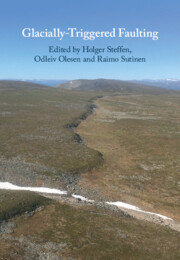Book contents
- Glacially-Triggered Faulting
- Glacially-Triggered Faulting
- Copyright page
- Contents
- Figures
- Tables
- Contributors
- Preface
- Part I Introduction
- 1 Glacially Triggered Faulting
- 2 Geomechanics of Glacially Triggered Faulting
- Part II Methods and Techniques for Fault Identification and Dating
- Part III Glacially Triggered Faulting in the Fennoscandian Shield
- Part IV Glacially Triggered Faulting at the Edge and in the Periphery of the Fennoscandian Shield
- Part V Glacially Triggered Faulting Outside Europe
- Part VI Modelling of Glacially Induced Faults and Stress
- Part VII Outlook
- Index
- References
2 - Geomechanics of Glacially Triggered Faulting
from Part I - Introduction
Published online by Cambridge University Press: 02 December 2021
- Glacially-Triggered Faulting
- Glacially-Triggered Faulting
- Copyright page
- Contents
- Figures
- Tables
- Contributors
- Preface
- Part I Introduction
- 1 Glacially Triggered Faulting
- 2 Geomechanics of Glacially Triggered Faulting
- Part II Methods and Techniques for Fault Identification and Dating
- Part III Glacially Triggered Faulting in the Fennoscandian Shield
- Part IV Glacially Triggered Faulting at the Edge and in the Periphery of the Fennoscandian Shield
- Part V Glacially Triggered Faulting Outside Europe
- Part VI Modelling of Glacially Induced Faults and Stress
- Part VII Outlook
- Index
- References
Summary
The reactivation of glacially induced faults is linked to the increase and decrease of ice mass. But, whether faults are reactivated by glacially induced stresses depends to a large degree on the crustal stress field, fault properties and fluid pressures. The background (tectonic and lithostatic) stress field has a major effect on the potential for reactivation, as the varying stresses induced by the ice sheet affects the state of stress around the fault, bringing the fault to more stable or more unstable conditions. Here, we describe the effect of glacially induced stresses on fault reactivation under three potential background stress regimes of normal, strike-slip and thrust/reverse faulting. The Mohr diagram is used to illustrate how glacially induced stresses affect the location and the size of the Mohr circle. We review these different cases by applying an analysis of the stress state at different time points in the glacial cycle. In addition, we present an overview of fault properties that affect the reactivation of glacially induced faults, such as pore-fluid pressure and coefficient of friction.
Keywords
- Type
- Chapter
- Information
- Glacially-Triggered Faulting , pp. 20 - 40Publisher: Cambridge University PressPrint publication year: 2021
References
- 4
- Cited by



